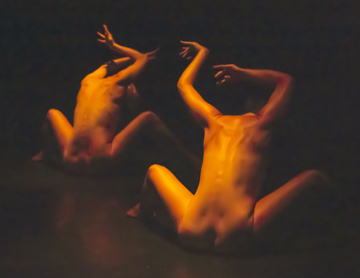Dance: Madrid Shows Some Skin at the Edinburgh Fringe
By Justine Bayod Espoz
ART TIMES November 2016
 Poliana & Unge |
The Edinburgh Festival Fringe is best known for being the largest performing arts festival in the world. With over 3000 performances taking place during the 2016 edition, it seems there’s no real limit to the festival’s magnitude. Although the vast majority of productions featured are presented by British companies and artists, one gets the feeling that Fringe organizers, venues and audiences are beginning to pay more attention to international productions.
Scotland’s National Center for Dance, Dance Base, turns into an exclusively dance and physical theatre venue during the Fringe, as its studios convert into theatres for the month of August. Unlike the majority of Fringe venues, Dance Base’s program is curated by Artistic Director Morag Deyes, and as such, is a pioneering force within the festival when it comes to presenting as stylistically varied and international a program as possible.
Among Dance Base’s featured productions, there were such masterfully hewn gems as the Dublin-based Ériu Dance Company’s Lïnger, which presented an emotive and flawlessly elegant modernist take on Irish step dancing, or Danish company DON GNU’s intensely physical, perilously acrobatic and side-splittingly hilarious M.I.S. – All Night Long.
It was exciting to see that in the midst of such enviable artistic company there was one company from Madrid, Spain. My nationalistic enthusiasm cooled, however, when I learned that the very aptly named FLESH featured two entirely nude female dancers. Anyone who has explored the Madrid contemporary dance scene knows that any time you see a local production there’s about an 80% chance you’ll get a full frontal eyeful. Nudity in Spain is not as embarrassing or shocking an affair as it is in other countries, so this means that it is often used gratuitously in certain art forms with little real effect other than to inspire a sigh of “here we go again.”
Past experience made me doubt FLESH’s artistic choices and validity before I even saw the production. Well, shame on me, for FLESH was not gratuitous or vulgar, it was subtle and sleek and a beautiful homage to the versatility of the human form.
The choreographic duo known simply as Poliana & Unge - comprised of Brazilian Poliana Lima and Lithuanian Ugne Dievaityte – bravely use bare bodies as a canvas upon which otherworldly forms warp, transform and blend. Their reliance upon one another to form esthetically unique constructions by intertwining limbs or rolling and arching back to back also displays an intense connection between the dancers, a connection that they describe in the program notes as a dialog from which the piece’s most important merit emerges, “the construction of mutual trust and continuous negotiation.”
Poliana & Unge credit Madrid – the city where they met and now live and work - for the creation and inspiration of this piece, as it provided fertile artistic ground on which to explore the ideas of foreignness and discovery. “When deciding to move to Madrid, we were both looking for a place where we could find similarities instead of differences. Madrid and our own bodies revealed a place where we could search and inquire about our identity. FLESH is about who we are, where we are, and who is the other.”
The duo admit that the production has seen many variations and adaptations but claims that with their Fringe performance they’ve found its most minimal and precise form. This stays true to their artistic credo, which they declare as “striving to find the poetics of abstract and minimalist movement by giving prominence to the physicality and presence of the body.”
The crowning glory of FLESH is that it manages not only to completely desexualize the nude female form – a real challenge in today’s society – but to find organic ways of deconstructing the human body and then molding it into something that is both foreign yet familiar. Their beautifully contorted figures remind the audience of strange life forms, maybe from the ocean’s depths or from the far reaches of the galaxy. To a large degree, this is achieved through the use of very subtle, soft lighting that illuminates their figures just enough to allow us to focus on the shapes, edges and curves of their bodies, while blurring the fine details that make each human form unique. The illumination also generates a certain mystique, almost as though you are watching these strange transformations through a haze.
The ethereal nature of Poliana & Unge’s creation is instantly understandable when they speak about their process. Work on FLESH “began with research into movement of the head. Consequently, we began asking questions about how the body can exist without a head. A lot of ideas came out of this experiment, and we realized that whilst a head’s movement relates to the duality of power and submission, a body without a head creates a ‘non-human’ atmosphere. Without the head, there’s no human identity.”
Anyone who sees FLESH will soon realize that Poliana & Unge have, effectively and with great aesthetic aplomb, stripped the human form of its humanity. This may sound harsh and almost aggressive, but it is in actuality visually engrossing and oddly beautiful.
